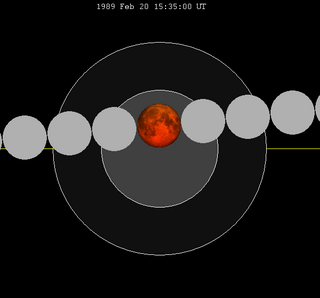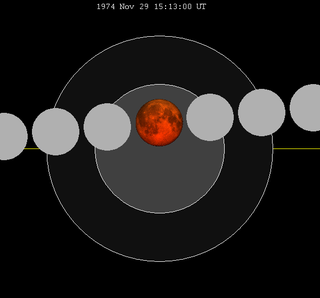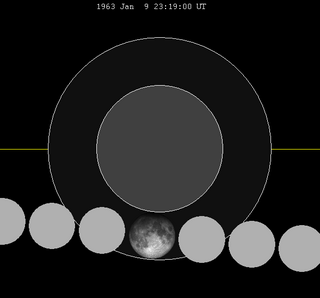| Partial eclipse | |||||||||||||
| Date | April 13, 1930 | ||||||||||||
|---|---|---|---|---|---|---|---|---|---|---|---|---|---|
| Gamma | 0.9545 | ||||||||||||
| Magnitude | 0.1064 | ||||||||||||
| Saros cycle | 111 (62 of 71) | ||||||||||||
| Partiality | 73 minutes and 22 seconds | ||||||||||||
| Penumbral | 267 minutes and 18 seconds | ||||||||||||
| |||||||||||||
A partial lunar eclipse took place on Sunday, April 13, 1930.
| Descending node | Ascending node | |||||
|---|---|---|---|---|---|---|
| Saros | Date Viewing | Type Chart | Saros | Date Viewing | Type Chart | |
| 111 | 1930 Apr 13  | Partial | 116 | 1930 Oct 07  | Partial | |
| 121 | 1931 Apr 02  | Total | 126 | 1931 Sep 26  | Total | |
| 131 | 1932 Mar 22  | Partial | 136 | 1932 Sep 14  | Partial | |
| 141 | 1933 Mar 12  | Penumbral | 146 | 1933 Sep 04  | Penumbral | |
Lunar Saros 111, repeating every 18 years and 11 days, has a total of 71 lunar eclipse events including 11 total lunar eclipses. The first total lunar eclipse of this series was on April 19, 1353, and last was on August 4, 1533. The longest occurrence of this series was on June 12, 1443 when the totality lasted 106 minutes.

A total lunar eclipse took place on November 9, 2003, the second of two total lunar eclipses in 2003, the first being on May 16, 2003. It is the first total lunar eclipse of 21st century which happened in a micromoon day.

A total lunar eclipse took place on Sunday 16 July 2000, the second of two total lunar eclipses in 2000.

A total lunar eclipse took place on Monday, February 20, 1989, the first of two total lunar eclipses in 1989.

A partial lunar eclipse took place on 25 April 2013, the first of three lunar eclipses in 2013. Only a tiny sliver (1.48%) of the Moon was covered by the Earth's umbral shadow at maximum eclipse, but the entire northern half of the Moon was darkened from being inside the penumbral shadow. This was one of the shortest partial eclipses of the Moon for the 21st century, lasting 27 minutes. This was the last of 58 umbral lunar eclipses of Lunar Saros 112.

A penumbral lunar eclipse took place on Sunday, January 31, 1999, the first of two lunar eclipses in 1999.

A total lunar eclipse took place on 4 April 2015. It is the former of two total lunar eclipses in 2015, and the third in a tetrad. Other eclipses in the tetrad are those of 15 April 2014, 8 October 2014, and 28 September 2015.

A total lunar eclipse took place on Monday, October 28, 1985, the second of two total lunar eclipses in 1985, the first being on May 4, 1985.

A penumbral lunar eclipse took place on Tuesday, May 15, 1984. This was a deep penumbral eclipse, with the southern limb of the Moon close to the Earth's shadow.

A total lunar eclipse took place on Friday, November 29, 1974, the second of two lunar eclipses in 1974.

A partial lunar eclipse occurred on 19 November 2021. The eclipse occurred towards a micromoon. This was the longest partial lunar eclipse since February 18, 1440, and the longest until February 8, 2669; however, many eclipses, including the upcoming November 2022 lunar eclipse will have a longer period of umbral contact at next to 3 hours 40 minutes. This was the second lunar eclipse of 2021 as well as the only partial lunar eclipse in a series of an almost tetrad from 2021 to 2022, followed by the May 16 and November 8, 2022, lunar eclipses, both of which are total.

A partial lunar eclipse took place on Monday, April 4, 1977. At maximum eclipse, a small bite out of the Moon should have been visible. The eclipse lasted for 1 hour and 34.76 minutes, with just 19.289% of the Moon in shadow at maximum.

A partial lunar eclipse took place on Tuesday, March 13, 1979, the first of two lunar eclipses in 1979. The Moon was strikingly shadowed in this deep partial eclipse which lasted 3 hours, 17 minutes and 40.6 seconds, with 85.377% of the Moon in darkness at maximum.

A penumbral lunar eclipse will take place on February 22, 2035. It will be visible to the naked eye as 96.52% of the Moon will be immersed in Earth's penumbral shadow.
A penumbral lunar eclipse will take place on June 17, 2038.

A partial lunar eclipse will take place on November 30, 2039.

A total lunar eclipse took place on Wednesday, October 18, 1967, the second of two total lunar eclipses in 1967, the first being on April 24, 1967.

A penumbral lunar eclipse took place on Wednesday, January 9, 1963, the first of three lunar eclipses in 1963.
A total lunar eclipse took place on Monday, September 15, 1913. The moon passed through the center of the Earth's shadow.
Saros cycle series 112 for lunar eclipses occurs at the moon's ascending node, 18 years 11 and 1/3 days. It contains 72 events, with 15 total eclipses, starting in 1364 and ending in 1616. Solar Saros 119 interleaves with this lunar Saros with an event occurring every 9 years 5 days alternating between each saros series.
Saros cycle series 114 for lunar eclipses occurs at the moon's ascending node, 18 years 11 and 1/3 days. It contains 71 member events, with 13 total eclipses, starting in 1458 and ending in 1674. Solar saros 121 interleaves with this lunar saros with an event occurring every 9 years 5 days alternating between each saros series.